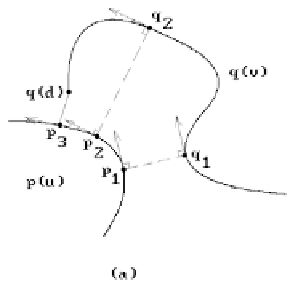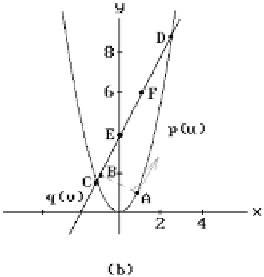Graphics Reference
In-Depth Information
Figure 14.2.
Distance between two curves.
are
(
)
(
)
(
)
=-
(
)
u v
,
111515
,
,
-
,
-
,
and
1515
+
,
+
.
The distance between
A
= p(1) = (1,1) on p(u) and
B
= q(-1) = (-1,2) on q(v) is a local
maximum. The curves intersect at
C
= (1 - , 1 - ) and
D
= (1 + , 1 + ). We
have not said anything about the domain of the curves. If it is
R
, then the distance
between them is zero since they intersect. On the other hand, if, for example, the
domain of p(u) is
R
but we had restricted the domain of q(v) to [0,1], so that q(v)
would only trace out the segment [
E
,
F
] in Figure 14.2(b), then the values we just com-
puted would not apply since they lie outside the domain of the current q(v). In fact,
in a real algorithm we would have gotten the answer that h(u,v) has no critical points
given our domains. To find the distance between p(u) and q(v) we would now have
had to go on and check the distance of the endpoints
E
= q(0) = (0,4) and
F
= q(1) =
(1,6) to p(u) and pick the closest distance.
5
5
5
5
Next, we move on to finding distances involving surfaces. If p(u,v) is a parame-
terization for a surface, let
(
)
=
(
)
¥
(
)
nuv puv puv
,
,
,
.
p
u
v
n
p
(u,v) will be a normal vector to the surface at p(u,v).
Point-surface Distance.
To find the distance between a point
p
and a parameter-
ized surface
[
]
¥
[
]
Æ
R
3
qab cd
:,
,
we look for a point
q
= q(u,v) on the surface with the property that
p
-
q
is orthogo-
nal to the tangent plane of the surface at
q
, that is, we need to solve the equations
(
(
)
)
(
)
=
p
p
-
quv
,
•
q uv
,
0
0
u
(
(
)
)
(
)
=
-
quv
,
•
q uv
,
.
(14.4)
v












